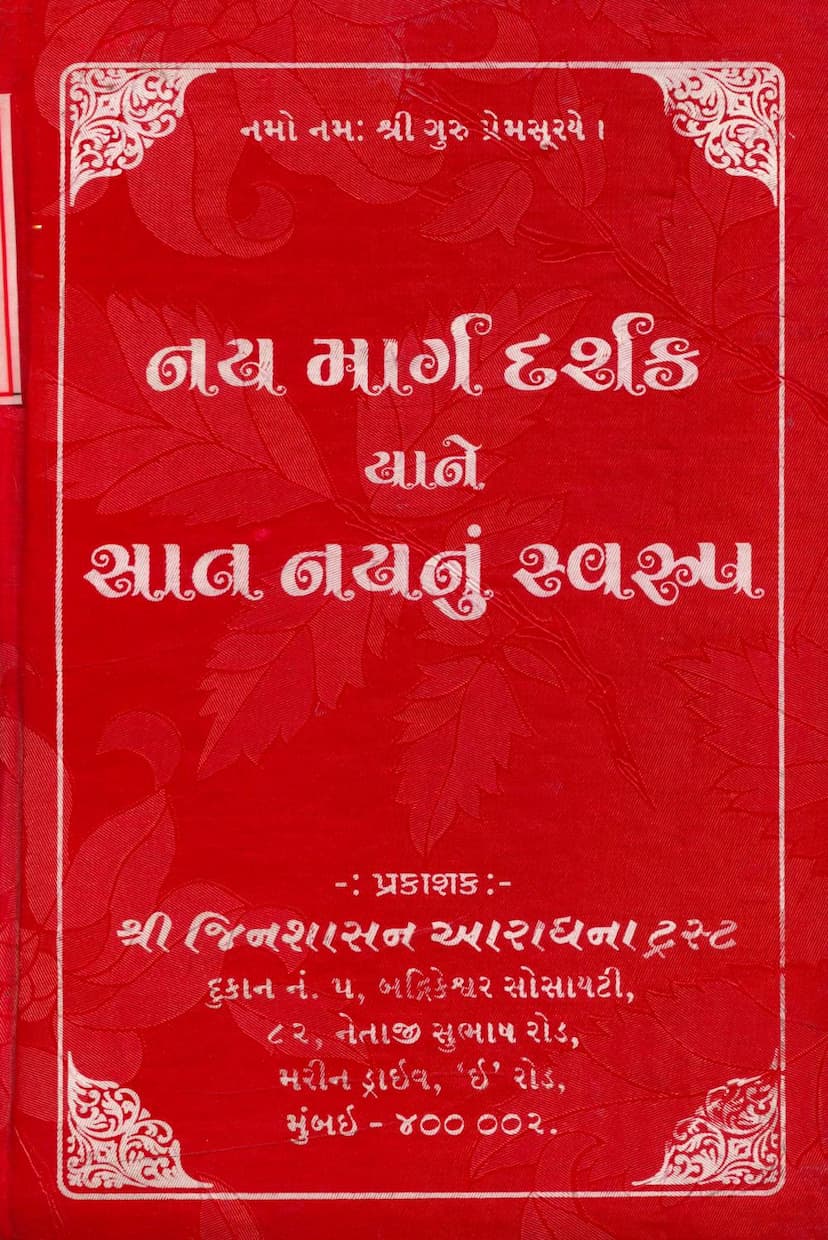Nay Margdarshak Yane Sat Naynu Swarup
Added to library: September 2, 2025

Summary
Here's a comprehensive summary of the Jain text "Nay Margdarshak Yani Sat Naynu Swarup" (The Guide to the Path of Nayas, i.e., the Nature of the Seven Nayas):
Book Overview:
- Title: Nay Margdarshak Yani Sat Naynu Swarup (The Guide to the Path of Nayas, i.e., the Nature of the Seven Nayas)
- Author(s): Jinshasan Aradhana Trust
- Publisher: Jinshasan Aradhana Trust
- Core Subject: This book, published by Jinshasan Aradhana Trust, is a guide to understanding the seven nayas (standpoints or perspectives) in Jain philosophy. These nayas are crucial for correctly interpreting the multifaceted nature of reality as explained in the Syadvada (the doctrine of conditioned predication) of Jainism. The book aims to help readers grasp these complex philosophical concepts and achieve spiritual liberation.
Narrative and Key Themes:
The book is presented as a narrative, likely an allegorical one, illustrating the journey of a seeker towards understanding the truth.
-
The Seeker, Nayachandra: The central character is Nayachandra, a young man from a devout Jain family, who is intelligent and spiritual but plagued by doubt and skepticism regarding Jain principles, particularly Syadvada. Despite his inherent faith and good upbringing, his mind is clouded by questions that even learned scholars cannot resolve. His wife, Subodha, is portrayed as virtuous and understanding, and his son, Jijnasu, is inquisitive and eager to learn.
-
The Quest for Clarity: Nayachandra's spiritual quest leads him and his family to undertake a pilgrimage to Siddhagiri (Mount Girnar). During this pilgrimage, he encounters a highly realized Jain muni (ascetic) named Anandasuri. Anandasuri, possessing divine knowledge, knows of Nayachandra's inner turmoil and arrives at Siddhagiri specifically to guide him.
-
The Importance of Nayas: Anandasuri explains that the root cause of Nayachandra's doubt lies in his incomplete understanding of the true nature of reality, which can only be grasped through the application of the nayas. He emphasizes that understanding the seven nayas is essential for comprehending the six dravyas (substances) and the nature of all entities, thereby dispelling doubt.
-
Explaining the Nayas: The narrative unfolds through a series of discourses between Anandasuri and Nayachandra's family, spread over seven pilgrimage days. Anandasuri systematically explains:
- The Nature of the Soul (Atma): He first elucidates the three states of the soul: Bahiratman (external self, identified with the body and possessions), Antaratman (internal self, striving for spiritual knowledge), and Paramatma (the Supreme Soul, liberated and perfected).
- The Six Dravyas: The six fundamental substances of Jainism (Jiva, Ajiva, Dharma, Adharma, Akasha, Kala) are introduced.
- Dravya's Qualities (Gunas) and Modifications (Paryayas): The book delves into the concept of dravya (substance) and its inherent qualities and temporary modifications, emphasizing the eternal nature of the substance versus the transient nature of its modifications.
- General and Specific Qualities/Natures: Anandasuri details the ten general qualities (samanya gunas) of dravyas and the sixteen specific qualities (vishesha gunas), explaining concepts like existence, non-existence, permanence, impermanence, self-nature, other-nature, etc. The discussion on swabhav (inherent nature) and vibhav (modified nature) is crucial.
- The Seven Nayas: The core of the book is the explanation of the seven nayas:
- Dravyarthika Naya (Substance-Oriented Perspective): This naya focuses on the eternal, unchanging essence or substance of things. It is further divided into ten categories, emphasizing different aspects of the substance.
- Paryayarthika Naya (Modification-Oriented Perspective): This naya focuses on the transient, changing aspects or modifications of a substance. It is explained through six categories, highlighting different states and changes.
- Examples and Analogies: The teachings are illustrated with numerous examples and analogies from Jain scriptures and daily life (e.g., a clay pot, the soul's states, the characteristics of Indra, the concept of karma).
- Nayaabhas (Misconceptions of Nayas): Anandasuri also clarifies the dangers of misinterpreting or exclusively adhering to one naya (known as nayaabhas), which leads to incorrect views and doctrinal errors. The importance of combining different nayas under the umbrella of Syadvada is highlighted.
- Knowledge vs. Action: The distinction between Jnana Naya (knowledge-focused perspective) and Kriya Naya (action-focused perspective) is discussed, emphasizing that while knowledge is foundational, purposeful action guided by knowledge is essential for spiritual progress.
-
Nayachandra's Transformation: Through these discourses, Nayachandra's doubts are gradually dispelled. He gains a profound understanding of Syadvada, the seven nayas, and the true nature of Jain philosophy. His skepticism transforms into firm conviction.
-
The Role of Gurus and the Sangha: The narrative also emphasizes the importance of enlightened gurus like Anandasuri and the collective spiritual practice of the Sangha (community of monks, nuns, and lay followers) in facilitating spiritual growth and understanding.
-
Conclusion and Call to Action: The book concludes with Anandasuri's final blessings and advice to Nayachandra and his family. He encourages them to uphold Jain principles, promote religious reform, practice compassion, and spread the teachings of Jainism. The narrative highlights the exemplary lives of Nayachandra, Subodha, and Jijnasu, who become instruments of spiritual propagation.
Key Takeaways for the Reader:
- Understanding Syadvada: The book is fundamentally about demystifying Syadvada by explaining the seven nayas that form its foundation.
- Resolving Doubts: It offers a method for resolving spiritual doubts by systematically approaching reality from multiple perspectives.
- Holistic View of Reality: Jain philosophy, particularly through the nayas, presents a complex, nuanced, and non-absolute view of reality, avoiding extreme positions.
- Importance of Both Knowledge and Action: The book stresses the integration of right knowledge (jnana) and right conduct (charitra) for spiritual liberation.
- Devotion and Inquiry: It showcases the power of devotion, humility, and persistent inquiry in the pursuit of truth.
In essence, "Nay Margdarshak" serves as a practical guide for Jains to understand and apply the sophisticated philosophical framework of the nayas in their spiritual journey, leading them from doubt to certainty and ultimately towards liberation.